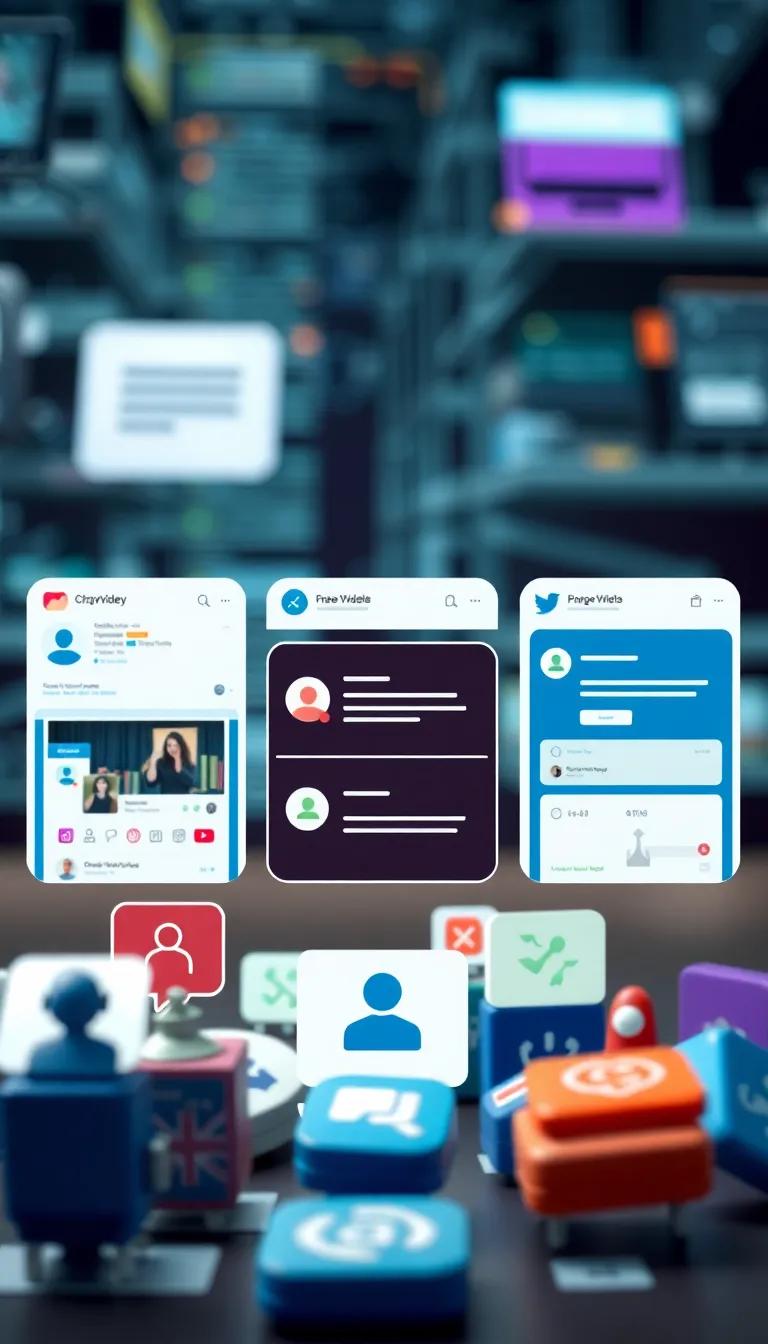Introduction
In the competitive digital landscape, the implementation of innovative tools like free website chat widgets has become essential for businesses aiming to improve customer engagement. This article delves into the critical aspects of industry analysis, demonstrating how businesses can leverage detailed market assessments to enhance the adoption and success of chat widgets. By understanding customer behaviors, preferences, and the overall market dynamics, organizations can develop effective strategies that not only attract users but also foster long-term loyalty.
We will explore the fundamental concepts of industry analysis, examining how frameworks such as Porter’s Five Forces can guide businesses in navigating the intricacies of their respective markets. This analysis will uncover the challenges and opportunities present for chat widgets, illustrating their potential impact on customer interaction and business outcomes. Through this comprehensive exploration, businesses can better position themselves to capitalize on the benefits offered by these tools.
The Importance of Industry Analysis Understanding Market Dynamics Impact on Business Strategy
In the quick-moving world of tech and customer service, checking out what’s happening in the industry is super important for companies looking to succeed. By looking into the competition, market trends, and what customers want, businesses can come up with plans that not only meet today’s needs but also get ready for what’s next. This kind of deep dive is key to giving helpful tips that help with decision-making and shape how products are developed.
A well-rounded industry analysis delves into several critical areas. First, it assesses the competitive environment. By identifying key players and their market share, businesses can pinpoint where they stand relative to competitors. This insight allows firms to assess their unique value propositions and identify gaps in the market that can be addressed. Additionally, by keeping a keen eye on competitors’ innovations and customer engagement strategies, companies can adapt and enhance their own offerings, thus avoiding stagnation and ensuring relevance.
Getting a grip on market trends is super important for spotting new chances. Take free website chat widgets as an example. The rise in digital communication shows that people are leaning more toward quick feedback and support. If businesses look at things like tech improvements, what customers want, and any new rules, they’ll get a better idea of where things are going. This kind of insight helps companies adjust to what consumers are looking for.
Industry analysis helps you get a better grip on who your customers are and what they care about. When you know your target audience and understand their buying habits and what drives them, you can create experiences just for them. This personalized touch can really boost how happy customers feel and keep them coming back, which is super important in today’s business world.
Finally keeping an eye on industry trends helps companies stay flexible and quick on their feet. If businesses can easily adjust to new info or changes in the market it makes them tougher in tough times. Both new startups and seasoned players can gain a real advantage by being adaptable which is getting increasingly important these days. Understanding how the market works not only boosts the success of free website chat tools but also helps businesses better meet what their customers want and need.
Understanding Customer Needs Analyzing Customer Preferences and Behaviors to Drive Free Website Chat Widget Success
Identifying Customer Pain Points
For businesses seeking to implement successful chat widgets, grasping customer preferences and behaviors is paramount. A deep understanding of customer pain points allows organizations to tailor their chat functionalities, enhancing user experience significantly. By identifying what customers struggle with, whether it’s a complicated navigation process or delays in receiving assistance, businesses can create chat widgets that address these issues directly, thus fostering a sense of responsiveness and care among the clientele.
Leveraging Data Analytics for Improvement
Utilizing data analytics serves as a powerful tool in understanding customer behavior. By evaluating interaction metrics, such as frequency of inquiries, response times, and the most common questions asked, businesses can fine-tune their chat widget features to meet user expectations effectively. For instance, if analytics reveal that a large volume of chat inquiries revolve around a specific service or product, companies can optimize their chat features to highlight this information or even preemptively offer assistance on related queries. This proactive approach not only enhances customer satisfaction but can also increase conversion rates as users perceive the brand to be attentive and customer-centric.
Engagement through Personalization
Personalizing the chat experience is another critical factor in engaging customers. When chat interactions feel tailored to individual preferences, users are more likely to feel valued and understood. Implementing chatbots that can recognize returning visitors or remember past interactions can transform the standard chat experience into a more engaging dialogue. Personalization can extend beyond mere greetings; it can incorporate relevant recommendations based on previous interactions, thereby improving the overall effectiveness of the chat widget.
Feedback Mechanisms for Continual Refinement
Establishing feedback mechanisms allows companies to continually assess the performance of their chat widgets. Post-interaction surveys can help gather customer insights about their experiences and gauge satisfaction levels. This information is vital for ongoing enhancement. Adaptation based on real-time feedback enables businesses to not only rectify shortcomings but also evolve their chat systems in sync with shifting customer expectations and preferences.
The strategic analysis of customer needs and behaviors is instrumental for the implementation of successful chat widgets. Employers who prioritize understanding their clientele will likely see improved interaction quality, leading to increased loyalty and overall business success.
Competitive Landscape of Chat Widgets Examining Market Dynamics
Key Players and Their Strategies in the Chat Widget Industry
The competitive landscape of free website chat widgets is characterized by a diverse range of players, each employing distinct strategies to capture market share. A number of companies have emerged as leaders in this sector, driven by their focus on innovation, user experience, and integration capabilities. This dynamic environment is influenced by several factors, including technological advancements, customer preferences, and market trends.
Among the prominent players, many prioritize offering free versions of their chat widgets, which serve as an enticing entry point for small and medium-sized enterprises. Companies like Tawk.to, LiveChat, and Zendesk have gained significant traction by providing flexible and user-friendly solutions that cater to various business needs. These platforms often include features such as real-time messaging, automated responses, and analytics, which enhance customer engagement while minimizing operational costs.
The strategies employed by these key players vary widely but generally focus on creating a positive user experience. For instance, Tawk.to emphasizes its completely free service as a way to build a large user base, while Zendesk positions itself as a comprehensive customer support platform that integrates chat solutions with other tools. This strategic positioning allows companies to appeal to different market segments, from startups to large enterprises, and to address specific customer pain points effectively.
Some players in the market are leveraging Artificial Intelligence (AI) to improve their chat offerings. By integrating AI-driven chatbots, these companies can automate repetitive tasks and provide instant support to users. This not only enhances operational efficiency but also enriches the overall customer journey. Players that effectively harness AI capabilities often differentiate themselves from competitors, providing a more robust and intelligent chat experience.
Partnerships and integrations with other software platforms are another common strategy among leading chat widget providers. By connecting their services with popular customer relationship management (CRM) systems, eCommerce platforms, and social media channels, these companies broaden their reach and improve customer accessibility. As businesses aim for a seamless multichannel experience, this integration becomes a pivotal factor in a chat widget’s success.
As the competitive environment continues to evolve, organizations need to remain agile, consistently adapting to customer needs and leveraging technological advancements to maintain their foothold in the market. The landscape of free website chat widgets reflects a continual adaptation, poised to enhance customer engagement as new competitors and innovations emerge.
Opportunities and Threats in the Chat Widget Market
Identifying Market Opportunities
The free website chat widget market presents significant opportunities for businesses seeking to enhance customer engagement and streamline communication. One prominent opportunity is the growing demand for real-time customer support. As internet usage increases, consumers expect immediate responses to their queries; failing to meet these expectations can lead to customer dissatisfaction. Implementing a chat widget on websites can significantly bridge this gap, therefore positioning businesses advantageously in competitive landscapes.
Another opportunity arises from technological advancements. AI and machine learning innovations continue to shape the chat widget landscape, enabling more sophisticated interactions between customers and brands. Widgets equipped with advanced capabilities, such as natural language processing, can offer personalized responses, enhancing user experiences and increasing conversion rates. Providers that leverage these technologies will likely outperform competitors that rely on more traditional chat solutions.
The growing trend of remote work has intensified the need for businesses to maintain strong communication channels. Chat widgets can serve as essential tools for not only customer engagement but also team collaboration. Companies that integrate chat solutions into both their customer-facing and internal communications will find themselves better positioned to adapt to evolving operational trends.
Assessing Market Threats
Despite the range of opportunities, the chat widget market is not without its challenges. One notable threat is the saturation of the market with various chat solutions. As numerous companies vie for visibility, distinguishing a chat widget’s unique features can become increasingly difficult. Businesses may find it challenging to justify the investment in premium features when a plethora of free options exist.
Customer privacy concerns present a significant threat. With increasing regulations regarding data protection, businesses must be cautious about how they manage and utilize customer information collected via chat widgets. A failure to comply with privacy laws can result in legal repercussions and damage to brand reputation.
Technological shifts can also pose threats. Rapid advancements in online communication technologies may render existing chat solutions obsolete. Companies that fail to innovate or adapt their widgets to meet emerging trends risk losing market share to more agile competitors. Maintaining market relevance thus requires continuous investment in research and development.
Integrating Chat Widgets with Business Strategies Enhancing Customer Engagement
Strategic Integration of Chat Widgets
For businesses aiming to amplify their customer engagement strategies, the integration of free website chat widgets plays a pivotal role. These tools facilitate seamless communication between the company and its clientele, positioning themselves as vital components in the broader marketing landscape. The successful incorporation of chat widgets hinges largely upon aligning their functionalities with specific business objectives.
First and foremost, organizations should identify their primary goals for customer interaction. Whether the focus is on boosting sales conversion, enhancing customer satisfaction, or streamlining customer service, chat widgets can be customized to meet these needs. By utilizing features such as automated responses for frequently asked questions, businesses can optimize resource allocation and ensure that live agents are available for more complex inquiries. This approach not only enhances operational efficiency but also improves the overall customer experience.
Analyzing customer behavior is essential in determining how chat widgets can serve specific market segments effectively. Implementing analytics tools enables companies to monitor chat interactions, gaining insight into customer preferences and pain points. This data can inform marketing strategies, allowing businesses to tailor their messaging and promotions accordingly. For instance, if data indicates that customers frequently ask about a particular product, targeted campaigns or informational content can be developed to address these interests.
Aligning Chat Widgets with Marketing Strategies
Marketing teams should also consider how chat widgets can complement ongoing campaigns. For example, during a promotional event, chat widgets can be programmed to provide real-time support, guiding customers through purchase processes or answering questions about special offers. This proactive engagement can significantly influence purchasing decisions, leading to higher conversion rates.
Integrating chat widgets into email marketing campaigns can reinforce brand messaging. By including links to chat features, potential customers have immediate access to support, which can alleviate uncertainty and encourage prompt decision-making. As customers increasingly expect instant responses, merging chat capabilities with existing marketing channels ensures that businesses remain competitive.
As the customer service landscape evolves, understanding market dynamics is vital. Businesses that effectively incorporate chat widgets into their strategies not only enhance customer engagement but also build a more responsive and adaptable organizational structure, laying the groundwork for sustained success in the ever-changing marketplace.
Future of Free Website Chat Widgets Speculating on Trends through Industry Analysis
Anticipating Market Dynamics
The future of free website chat widgets is intricately linked to an evolving landscape shaped by buyer behavior, technological advancements, and competitive pressures. Through comprehensive industry analysis, a few key trends emerge that are likely to determine the trajectory of these tools in customer engagement.
One significant trend is the growing preference for personalized communication. As consumer expectations evolve, businesses are increasingly adopting AI-driven chat widgets to tailor interactions based on user behavior and preferences. This shift towards customization will not only enhance the user experience but also drive customer loyalty. Expect more chat widgets to include advanced machine learning algorithms that can analyze conversation patterns and optimize responses accordingly.
Another phenomenon is the integration of chat widgets into omnichannel strategies. Organizations will seek to create seamless experiences across various platforms—social media, websites, and mobile apps. The chat widget will serve as a central hub for communication, ensuring that businesses can interact with customers effectively, irrespective of the channel. This omnichannel approach is projected to make chat widgets more versatile, offering a unified platform for customer service.
The Role of Data Analytics
Data analytics is poised to play a pivotal role in shaping the future of free website chat widgets. With the capacity to collect and analyze user interactions in real-time, businesses can gain valuable insights into customer preferences and behaviors. This information will not only allow companies to refine their communication strategies but also enable them to preemptively address consumer concerns. As organizations harness big data, we can anticipate a higher degree of automation and self-service functionalities being incorporated into chat solutions.
The competitive landscape is also driving innovation. With the proliferation of free chat widget solutions, differentiating features such as multilingual support and integration with existing CRM systems will become essential. Companies will prioritize scalability and flexibility to meet the diverse needs of their clientele, resulting in a more robust market offering.
As these trends unfold, free website chat widgets will likely evolve from simple communication tools into sophisticated platforms that not only enhance customer engagement but also drive conversion rates and operational efficiency. Understanding these dynamics will empower businesses to leverage chat widgets effectively, securing their place in the market while meeting the demands of today’s consumers.
Conclusions
Industry analysis plays a vital role in shaping the strategies businesses adopt to implement free website chat widgets successfully. By evaluating the market landscape, understanding customer needs, and recognizing competitive forces, organizations can develop robust plans that not only integrate chat widgets effectively but also maximize their potential to enhance customer engagement. Companies that prioritize a thorough understanding of their industry will be better equipped to adapt to changes and leverage new opportunities.
Looking ahead, it is evident that the chat widget market is poised for significant growth driven by technological advancements and evolving customer expectations. Businesses must stay attuned to these trends, ensuring that their chat solutions remain relevant and effective. As the importance of real-time customer interaction continues to rise, adopting a proactive approach in industry analysis will be crucial for long-term success in this evolving landscape.


















